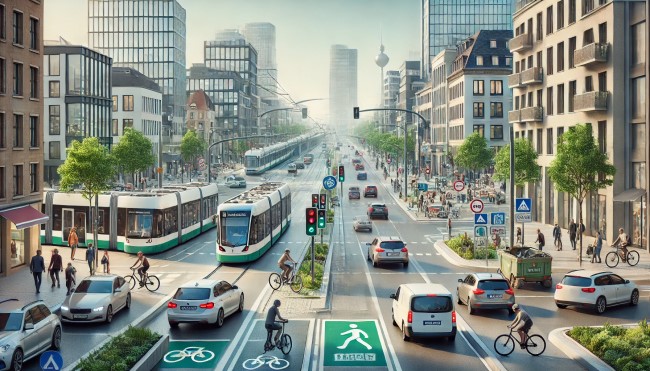Traffic Impact Assessment: Ensuring Sustainable Development in Germany

Traffic impact assessment (TIA) plays a pivotal role in urban planning, ensuring that new developments in Germany integrate seamlessly with existing transportation infrastructure. A thorough TIA helps mitigate the potential adverse effects of increased traffic, ensuring road safety, environmental sustainability, and efficient transportation systems for the community.
Introduction
Germany’s thriving urban development and transportation network demand stringent measures to manage traffic and mitigate its potential impacts. As cities continue to grow and expand, it is vital to assess how new developments will influence existing road networks. Traffic Impact Assessments (TIA) serve as an essential tool in this regard, enabling authorities to foresee the implications of additional traffic and implement mitigation strategies.
This article delves into the details of traffic impact assessments, why they are crucial for development in Germany, and how they contribute to sustainable growth.
What is Traffic Impact Assessment?
A Traffic Impact Assessment (TIA) is a systematic process used to evaluate the effects of new developments on existing traffic systems. It predicts the potential increase in traffic volumes and assesses whether the current infrastructure can handle these changes. The main objective is to ensure that the development integrates seamlessly with the transportation network while maintaining road safety, reducing congestion, and minimizing environmental impacts.
The Importance of TIA in Germany
With its dense urban centers, Germany’s infrastructure is often stretched to its limits. Conducting TIAs ensures that new developments do not exacerbate traffic problems. These assessments help local governments and city planners make informed decisions by evaluating the impact on traffic patterns and infrastructure, reducing potential future disruptions.
Germany’s approach to sustainable urban growth places particular emphasis on the environmental effects of traffic. For example, in cities like Berlin, TIAs have played a role in reducing emissions through traffic management strategies, including speed limit regulations and road upgrades.
Legal Requirements for TIA in Germany
In Germany, TIAs are mandatory for projects that will generate significant additional traffic, especially during peak hours. Local and federal authorities impose this requirement as part of the planning permission process. The Federal Ministry of Transport and Digital Infrastructure (BMVI) provides detailed guidelines to ensure that these assessments meet rigorous standards for accuracy and effectiveness.
Depending on the size and type of development, developers are required to consult qualified traffic engineers to prepare and submit the TIA reports. The report typically covers the following aspects:
- Existing traffic conditions: Analysis of the current traffic situation in the area.
- Projected traffic growth: Future traffic estimates due to the development.
- Impact on road capacity: Whether the roads and intersections can accommodate the increased traffic.
- Mitigation strategies: Proposals to alleviate potential traffic issues.
How TIAs are Conducted
A thorough Traffic Impact Assessment involves multiple steps:
- Data Collection: Current traffic data is gathered, including vehicle counts, traffic flow patterns, and intersection performance.
- Trip Generation Analysis: This step estimates the number of trips that the new development will generate, especially during peak travel times.
- Traffic Distribution: This involves predicting how the new trips will be distributed across the existing road network.
- Capacity Analysis: Evaluating the capacity of intersections and roadways to handle increased traffic.
- Impact Evaluation: Assessing how the new traffic will affect travel times, congestion, road safety, and environmental factors such as air quality.
- Mitigation Proposals: Recommendations may include expanding roads, adding new traffic signals, or introducing public transport options.
Factors Influencing Traffic Impact in Germany
Several factors are unique to Germany when it comes to traffic impact assessment:
- Population Density: Germany’s urban areas are densely populated, making traffic management a priority.
- Environmental Regulations: Germany’s strong environmental policies necessitate that TIAs also assess the environmental impacts of traffic, including emissions and noise pollution.
- Public Transportation Infrastructure: Many cities in Germany rely heavily on public transport. TIAs often consider how new developments will integrate with public transportation options.
Challenges in Conducting TIAs in Germany
Conducting a TIA is not without its challenges:
- Data Availability: Gathering accurate and current data can be time-consuming and expensive.
- Complex Road Networks: Germany’s intricate and often congested road networks require comprehensive modeling to accurately predict the impact of new developments.
- Changing Regulations: Environmental standards and traffic management policies are continually evolving in Germany, making it necessary for TIAs to keep pace with legislative changes.
Case Study: TIA in Berlin’s Urban Development
Berlin serves as a prime example of how TIAs have been used to facilitate urban development while maintaining road safety and minimizing traffic congestion. The implementation of a reduced speed limit on certain busy roads, following a detailed TIA, led to significant reductions in emissions and noise pollution. This initiative, combined with improved public transportation options, helped maintain an acceptable level of service (LOS) on some of the city’s busiest roads.
Environmental Impact of Traffic in Germany
One of the key components of TIAs in Germany is assessing the environmental impact of increased traffic. With strict EU regulations in place, German cities are focused on reducing NO2 emissions and particulate matter (PM10). For example, in Berlin, TIAs have led to reduced speed limits in heavily trafficked areas, significantly lowering NO2 levels and benefiting local residents’ health.
Mitigation Measures and Their Importance
The outcome of a TIA often includes a series of recommendations aimed at mitigating the adverse effects of additional traffic. These can range from relatively minor changes, such as adjusting traffic signal timings, to more substantial infrastructure upgrades, like road widening or constructing new access roads.
In Germany, sustainable development is a priority, and the mitigation measures proposed through TIAs often align with broader environmental and mobility goals. Examples of these measures include:
- Encouraging Public Transportation: Promoting the use of public transport over private vehicles to reduce road congestion.
- Introducing Bicycle Lanes: Expanding infrastructure for cyclists to promote eco-friendly travel options.
- Optimizing Traffic Signals: Implementing intelligent traffic systems that adapt to real-time conditions.
The Role of Technology in Modern TIAs
As technology advances, so too does the methodology behind TIAs. In Germany, the integration of Geographic Information Systems (GIS) and traffic simulation software allows for more accurate and dynamic modeling of traffic impacts. These tools can provide real-time traffic flow data, enabling engineers to assess the effectiveness of different mitigation measures.
Additionally, Smart Cities initiatives in Germany are leveraging technology to improve urban mobility. Intelligent traffic management systems, autonomous vehicles, and predictive analytics are gradually becoming part of the traffic planning landscape.
Incorporating HR software can streamline the management of staff involved in traffic impact assessment projects, ensuring that payroll and employee data are efficiently tracked.
Conclusion
Traffic Impact Assessments are an indispensable tool in Germany’s urban development process. They ensure that new developments do not overwhelm the existing road network while promoting sustainable growth. As Germany continues to prioritize environmental sustainability and efficient urban planning, the importance of TIAs will only grow. By adhering to stringent assessment criteria and leveraging the latest technology, developers and city planners can minimize the adverse effects of increased traffic, creating safer, more livable cities for all.



